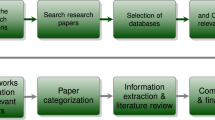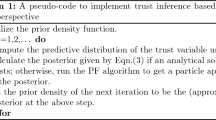Abstract
We propose in this paper a new approach for bootstrapping trust of Web services in which the interactions of a Web service with a user are observed during a certain time frame. The observations sequence is modeled as a Hidden Markov Model and matched against pre-defined trust patterns in order to assess the behavior of such Web service. The pre-defined trust patterns are specifications of possible behaviors of Web services such as trusted, malicious, betraying, oscillating, and redemptive. Based on the matching result, an initial trust value is assigned to the Web service. Our experimental results show that our approach enjoys good precision and recall values and provides a fair distribution of trust values. Besides, the proposed approach is applied on a dataset of real-world Web services. A comparative study with published bootstrapping approaches shows a better bootstrapping success rate for our new approach.













Similar content being viewed by others
Notes
The training and testing sequence sets do not overlap in all the experiments carried out in this research.
The sole exception is the recall measure for the trusted category.
An entropy is considered low if it is smaller than a certain threshold. In this experiment, that threshold is set to 1.
We use the average attribute value as the expected value just for the sake of this experiment. Ideally, the expected value of each attribute is taken from the service level agreement (SLA) of the corresponding service.
We can also involve the values of \(p\) and \(q\) in the complexity analysis in which case the HMM construction will require the order of \(pqKN^4n^2\) computations.
References
Plebani P, Pernici B (2009) URBE: Web service retrieval based on similarity evaluation. IEEE Trans Knowl Data Eng 21(11):1629–1642
Sánchez D, Isern D, Millan M (2011) Content annotation for the semantic web: an automatic web-based approach. Knowl Inf Syst 27:393–418
Chen C, Tseng F, Liang T (2011) An integration of fuzzy association rules and WordNet for document clustering. Knowl Inf Syst 28:687–708
Yahyaoui H (2012) A trust-based game theoretical model for web services collaboration. Knowl Based Syst 27:162–169
Xiong K, Perros H (2006) Trust-based Resource Allocation in Web Services. In: IEEE international conference on web services (ICWS’06) Chicago, Illinois, USA, pp 663–672
Malik Z (2008) Reputation-based trust framework for service oriented environments. PhD thesis, Virginia Polytechnic Institute and State University
Malik Z, Bouguettaya A (2009) RATEWeb: reputation assessment for trust establishment among web services. Very Large Data Bases (VLDB) 18(4):885–911
Malik Z, Bouguettaya A (2009) Reputation bootstrapping for trust establishment among web services. IEEE Internet Comput 13(1):40–47
Doshi P, Paradesi S, Swaika S (2009) Integrating behavioral trust in web service compositions. In: Proceedings of the seventh international conference on web services (ICWS’09). Los Angeles, CA, USA, pp 453–460
Cao L, Yu P (eds) (2012) Behavior computing: modeling, analysis, mining and decision. Springer, Berlin
Cao L (2010) In-depth behavior understanding and use: the behavior informatics approach. Inf Sci 180(17):3067–3085
Rabiner L (1989) A tutorial on Hidden Markov Models and selected applications in speech recognition. Proc IEEE 77(2):257–286
Rabiner L (1993) Fundamentals of speech recognition. Prentice Hall, Englewood Cliffs
Wright C, Monrose F, Masson G (2004) HMM profiles for network traffic classification. In: Proceedings of the ACM workshop on visualization and data mining for computer security. ACM, London, pp 9–15
Maia J, Filho R (2010) Internet traffic classification using a Hidden Markov Model. In: Proceedings of the 10th international conference on hybrid intelligent systems (HIS), pp 37–42
Krogh A, Larsson B, von Heijne G, Sonnhammer E (2001) Predicting transmembrane protein topology with a Hidden Markov Model: application to complete genomes. J Mol Biol 305:567–580
Shliep A, Georgi B, Rungsaritytin W, Costa I, Schonhuth A (2004) In: Kremer K, Macho V (eds) The general Hidden Markov Model Library: analyzing systems with unobservable states, pp 121–136
Yahyaoui H, Zhioua S (2011) Bootstrapping trust of web services through behavior observation. In: Proceedings of the 11th international conference on web engineering (ICWE 2011), pp 319–330
Baum LE, Egon JA (1967) An inequality with applications to statistical estimation for probabilitsic functions of a Markov process and to a model of ecology. Bull Am Meteorol Soc 73:360–363
Marti S, Garcia-Molina H (2006) Taxonomy of trust: categorizing P2P reputation systems. Comput Netw 50(4):472–484
Moukas A, Zacharia G, Maes P (2000) Collaborative reputation mechanisms in electronic marketplaces. Decis Supp Syst 29(4):371–388
Shannon C (1948) The mathematical theory of communication. Bell Syst Tech J 27:379–423
Chuong D, Batzogloul S (2008) What is the expectation maximization algorithm? Nat Biotechnol 26:897–899
Murphy K (2005) Hidden Markov Model (HMM) Toolbox for Matlab. http://www.cs.ubc.ca/murphyk/Software/HMM/hmm.html
Kohavi R (1995) A study of cross-validation and bootstrap for accuracy estimation and model selection. In: Proceedings of the international joint conference on artificial intelligence (IJCAI), pp 137–1143
Refaeilzadeh P, Tang L, Liu H (2009) Cross validation. Encyclopedia of database systems. Springer, Berlin, pp 532–538
Al-Masri E, Mahmoud Q (2007) Discovering the best web service. In: Proceedings of the 16th international world wide web conference, Banff, Canada, pp 1257–1258
Author information
Authors and Affiliations
Corresponding author
Rights and permissions
About this article
Cite this article
Yahyaoui, H., Zhioua, S. Bootstrapping trust of Web services based on trust patterns and Hidden Markov Models. Knowl Inf Syst 37, 389–416 (2013). https://doi.org/10.1007/s10115-012-0554-1
Received:
Revised:
Accepted:
Published:
Issue Date:
DOI: https://doi.org/10.1007/s10115-012-0554-1




